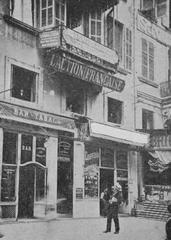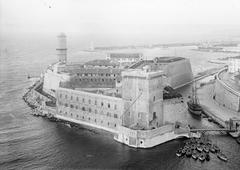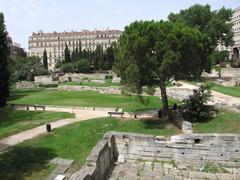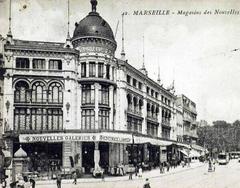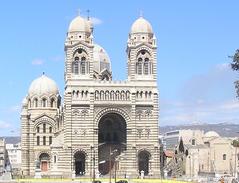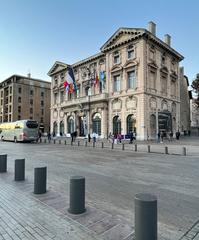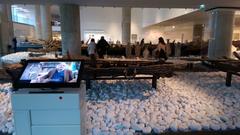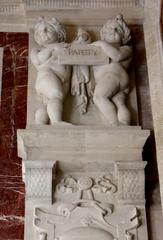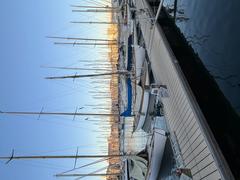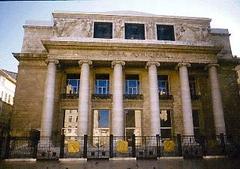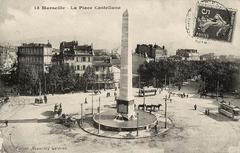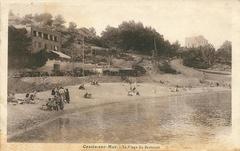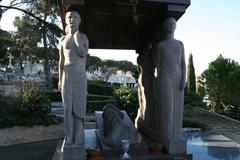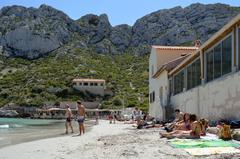
Comprehensive Guide to Visiting Marseille, Bouches-du-Rhône, France
Date: 13/08/2024
Captivating Introduction
Welcome to Marseille, a city where the Mediterranean breeze carries whispers of history and the streets are a living mosaic of cultures. Picture this: you’re standing in a port that’s been bustling since 600 BCE, founded by Greek sailors and later transformed into a Roman jewel. From the ancient walls of Vieux-Port to the neo-Byzantine splendor of Notre-Dame de la Garde, Marseille is a treasure chest waiting to be explored (World History Encyclopedia).
But there’s more to Marseille than just its historical landmarks. This city is a sensory feast where the aroma of freshly caught fish mingles with the vibrant sounds of street musicians. It’s a place where you can wander through the colorful streets of Le Panier, dive into a bowl of bouillabaisse, or lose yourself in the artistic vibes of the Cours Julien area. Whether you’re a history buff, a foodie, or an adventurer, Marseille has something to captivate your senses (Rick Steves, Voyage Tips).
Marseille’s rich tapestry is woven from threads of ancient civilizations, revolutionary fervor, and modern resilience. From the early Christian missionaries to the industrial boom, this city has been a melting pot of ideas, faiths, and cultures. The echoes of its past are etched in its landmarks, museums, and even its local lingo. So, buckle up and get ready for an unforgettable journey through time and culture. Marseille is not just a city to visit; it’s a city to experience (Wikipedia, Hey Explorer).
Table of Contents
- [The Historical Magic of Marseille](#the-historical-magic-of-marseillethe-historical-magic-of-marseille)
- [A Journey Through Time](#a-journey-through-timea-journey-through-time)
- [Rome’s New Jewel](#romes-new-jewelromes-new-jewel)
- [Early Christians and Mystical Legends](#early-christians-and-mystical-legendsearly-christians-and-mystical-legends)
- [Revolutionary Fervor and Anthem Birth](#revolutionary-fervor-and-anthem-birthrevolutionary-fervor-and-anthem-birth)
- [Industrial Boom and Immigrant Waves](#industrial-boom-and-immigrant-wavesindustrial-boom-and-immigrant-waves)
- [War, Resilience, and Modern Marvels](#war-resilience-and-modern-marvelswar-resilience-and-modern-marvels)
- [Landmark Treasures](#landmark-treasureslandmark-treasures)
- [Museums and Hidden Stories](#museums-and-hidden-storiesmuseums-and-hidden-stories)
- [Insider Tips for History Buffs](#insider-tips-for-history-buffsinsider-tips-for-history-buffs)
- [Discover the Hidden Charms and Iconic Landmarks](#discover-the-hidden-charms-and-iconic-landmarksdiscover-the-hidden-charms-and-iconic-landmarks)
- [Basilica of Notre-Dame de la Garde](#basilica-of-notre-dame-de-la-gardebasilica-of-notre-dame-de-la-garde)
- [Old Port (Vieux Port)](#old-port-vieux-portold-port-vieux-port)
- [Château d’If](#château-difchateau-dif)
- [The Calanques National Park](#the-calanques-national-parkthe-calanques-national-park)
- [Le Panier District](#le-panier-districtle-panier-district)
- [Palais Longchamp](#palais-longchamppalais-longchamp)
- [Corniche JF Kennedy](#corniche-jf-kennedycorniche-jf-kennedy)
- [Stade Vélodrome](#stade-vélodromestade-velodrome)
- [L’Estaque](#lestaquelestaque)
- [Musée d’Archéologie Méditerranéenne (MAM)](#musée-darchéologie-méditerranéenne-mammusee-darcheologie-mediterraneenne-mam)
- [La Vieille Charité](#la-vieille-charitéla-vieille-charite)
- [Cathédrale de la Major (Marseille Cathedral)](#cathédrale-de-la-major-marseille-cathedralcathedrale-de-la-major-marseille-cathedral)
- [Porte d’Aix](#porte-daixporte-daix)
- [Church of Notre-Dame-des-Accoules](#church-of-notre-dame-des-accouleschurch-of-notre-dame-des-accoules)
- [Insider Tips and Local Lingo](#insider-tips-and-local-lingoinsider-tips-and-local-lingo)
- [Seasonal Highlights](#seasonal-highlightsseasonal-highlights)
- [Myth Busting and Surprises](#myth-busting-and-surprisesmyth-busting-and-surprises)
- [Sample Itineraries](#sample-itinerariessample-itineraries)
- [Cultural Insights](#cultural-insightscultural-insights)
- [Historical Significance](#historical-significancehistorical-significance)
- [Architectural Heritage](#architectural-heritagearchitectural-heritage)
- [Museums and Cultural Institutions](#museums-and-cultural-institutionsmuseums-and-cultural-institutions)
- [Culinary Delights](#culinary-delightsculinary-delights)
- [Festivals and Events](#festivals-and-eventsfestivals-and-events)
- [Street Art and Urban Culture](#street-art-and-urban-culturestreet-art-and-urban-culture)
- [Music and Nightlife](#music-and-nightlifemusic-and-nightlife)
- [Local Markets](#local-marketslocal-markets)
- [Beaches and Outdoor Activities](#beaches-and-outdoor-activitiesbeaches-and-outdoor-activities)
- [Practical Information for Visitors](#practical-information-for-visitorspractical-information-for-visitors)
- [Best Time to Visit](#best-time-to-visitbest-time-to-visit)
- [Call to Action](#call-to-actioncall-to-action)
The Historical Magic of Marseille
A Journey Through Time
Ever wondered what it’s like to stroll through the oldest city in France? Welcome to Marseille, a city that’s been a bustling port and a melting pot of cultures since 600 BCE. Founded by Greek settlers from Phocaea (modern-day Turkey), this ancient city, known as Massalia, isn’t just old—it’s ancient! Imagine the scent of olive oil and wines mingling with the salty sea air as ships from all over the Mediterranean docked here, bringing with them goods, ideas, and spices (World History Encyclopedia).
Rome’s New Jewel
Marseille’s story took a dramatic twist during the Roman Civil War of 49 BCE. Picture this: the city, backing the wrong horse (Pompey) against Julius Caesar, gets besieged and conquered. Suddenly, Massalia becomes another glittering jewel in Rome’s crown, a gateway for goods and ideas between East and West. If walls could talk, the tales they’d tell of Roman soldiers and traders bustling through its streets (Wikipedia).
Early Christians and Mystical Legends
By 254 CE, nearby Arles had a Christian community, and by 314 CE, Marseille had its own. The port didn’t just bring in goods; it brought in new faiths. Imagine early Christian missionaries arriving, their robes fluttering in the sea breeze, ready to preach. Among the whispers of the wind, you might even catch tales of Lazarus, allegedly the city’s first bishop, or Mary Magdalene, who, local legend has it, found solace in the nearby mountains (World History Encyclopedia).
Revolutionary Fervor and Anthem Birth
Fast forward to the French Revolution, and Marseille is a hotbed of fervor. In 1792, local volunteers marched to Paris, singing what would become France’s national anthem, “La Marseillaise.” The city’s streets echoed with revolutionary zeal, with debates in its 90 Jacobin Clubs (Wikipedia). Can you hear the chants and footsteps of history?
Industrial Boom and Immigrant Waves
The 19th century saw Marseille bloom into an industrial powerhouse and colonial gateway. Picture steamships puffing as they set sail to North Africa, bringing back stories and people. The city’s skyline dotted with factory chimneys and its streets bustling with Italian immigrants and others seeking fortune. It’s a mosaic of cultures and stories, each adding a unique tile to the city’s vibrant history (Wikipedia).
War, Resilience, and Modern Marvels
World War II brought bombings, but Marseille bounced back with resilience. Post-war, the city welcomed waves of immigrants from North Africa, adding new spices to its cultural stew. Walk its streets today, and you’ll feel the pulse of a city that’s always adapting, always thriving (World History Encyclopedia).
Landmark Treasures
Marseille’s rich history is etched in its landmarks. Stand atop the Notre-Dame de la Garde, a basilica built between 1853 and 1864, and let the panoramic views take your breath away. Stroll through Vieux-Port, where history mingles with the aroma of fresh fish. Or visit the Château d’If, the fortress immortalized by Alexandre Dumas in “The Count of Monte Cristo.” Each brick and stone has a story to tell (Hey Explorer).
Museums and Hidden Stories
Dive deeper into Marseille’s past at the Museum of European and Mediterranean Civilizations (MuCEM) or the Marseille History Museum. Don’t miss the Musée des Docks Romains, showcasing artifacts that whisper tales of ancient trade (Wikipedia).
Insider Tips for History Buffs
To truly savor Marseille’s historical flavors:
- Notre-Dame de la Garde: Not just for the views—listen to the whispers of sailors’ prayers.
- Vieux-Port: Feel the heartbeat of Marseille in its bustling market.
- Château d’If: Let the fortress walls tell you tales of intrigue and escape.
- MuCEM: Discover the Mediterranean’s cultural tapestry.
- Marseille History Museum: Walk through time from Greek origins to modern marvels.
Marseille’s history isn’t just in books; it’s alive in its streets, its air, and its people. Ready to explore? Before you go, download Audiala, your ultimate audio guide app, to unlock the city’s secrets and stories. Bon voyage!
Discover the Hidden Charms and Iconic Landmarks
Basilica of Notre-Dame de la Garde: The Guardian of Marseille
Known affectionately as ‘La Bonne Mère,’ the Basilica of Notre-Dame de la Garde stands tall, watching over the city from its highest natural point. This neo-Byzantine gem, built between 1853 and 1864, offers jaw-dropping panoramic views of Marseille and the shimmering Mediterranean Sea. The interior is a feast for the eyes, adorned with intricate mosaics and a towering statue of the Virgin Mary. And hey, whether you hike up, drive, or hop on the tourist train from the Old Port, getting there is half the fun! (Voyage Tips)
Old Port (Vieux Port): The Beating Heart of Marseille
Imagine walking through a port that has been bustling since 600 BC! The Old Port, or Vieux Port, is not just a historic landmark but a vibrant area brimming with cafés, restaurants, and markets. Don’t miss the daily fish market – it’s a sensory explosion of fresh catches from the Mediterranean. Feeling adventurous? This is your launchpad for boat tours to the Calanques and the Château d’If. (Nomadic Matt)
Château d’If: The Fortress of Legends
Perched on the Île d’If, one of the Frioul Islands, the Château d’If is steeped in history and mystery. Built in the 16th century, it gained worldwide fame as the setting for Alexandre Dumas’ classic, ‘The Count of Monte Cristo.’ Once a prison for political and religious prisoners, today you can explore its cells and soak in tales of intrigue on a guided tour. Regular boats from the Old Port will whisk you away to this legendary fortress. (Voyage Tips)
The Calanques National Park: Nature’s Masterpiece
Imagine rugged limestone cliffs plunging into turquoise waters – that’s the Calanques National Park for you. Nestled between Marseille and Cassis, this natural wonder is perfect for hiking, boating, or kayaking. Whether you’re exploring Sormiou, Morgiou, or En-Vau, the park is a haven for rock climbers and snorkelers alike. (Voyage Tips)
Le Panier District: The Soul of Marseille
Step into Marseille’s oldest neighborhood, Le Panier, and you’ll feel like you’ve traveled back in time. This district is a maze of narrow streets, colorful buildings, and an artistic vibe that’s absolutely infectious. Explore La Vieille Charité, a former almshouse now home to museums and cultural spaces, or lose yourself in local boutiques and art galleries. And let’s not forget the bistros serving mouthwatering Provençal cuisine. (Voyage Tips)
Palais Longchamp: A Monument to Marseille’s Thirst
The Palais Longchamp is not just a stunning 19th-century monument; it’s a celebration of Marseille’s ingenious solution to its water woes. The palace complex, built to mark the completion of the Canal de Marseille, houses the Musée des Beaux-Arts and the Natural History Museum. Stroll through the surrounding park with its beautiful gardens, fountains, and sculptures. (Voyage Tips)
Corniche JF Kennedy: A Scenic Marvel
For breathtaking coastal views, the Corniche JF Kennedy is where it’s at. This scenic road offers stunning vistas of the Mediterranean, the Frioul Islands, and the Château d’If. Whether you’re walking, cycling, or jogging, don’t miss key spots like the Vallon des Auffes, a charming fishing port, and the Prado beaches, perfect for a dip. (Voyage Tips)
Stade Vélodrome: Where Football Dreams Come True
Football fans, rejoice! The Stade Vélodrome, home to the Olympique de Marseille football club, is a must-visit. With a seating capacity of over 67,000, it’s one of France’s largest stadiums and also hosts concerts and major events. Take a guided tour for a behind-the-scenes look at the locker rooms, VIP areas, and the pitch. (Voyage Tips)
L’Estaque: An Artist’s Muse
Once the muse of painters like Cézanne, Renoir, and Braque, L’Estaque is a charming district north of Marseille. Follow the ‘Petit Chemin des Peintres’ walking tour to see the landscapes that inspired these artists. Don’t miss the local beach and waterfront kiosks selling tasty local treats like chichis and panisses. (Voyage Tips)
Musée d’Archéologie Méditerranéenne (MAM): A Journey Through Time
Located in the Vieille Charité, the Musée d’Archéologie Méditerranéenne showcases artifacts from ancient Egypt, Greece, Rome, and the Near East. Highlights include Egyptian mummies and Greek pottery, offering a fascinating glimpse into the ancient civilizations that once thrived around the Mediterranean. (Nomads Travel Guide)
La Vieille Charité: A Cultural Hub
La Vieille Charité, a stunning 17th-century building in Le Panier, now houses several museums and cultural institutions. The central courtyard, with its beautiful Baroque architecture, is a sight to behold. Explore the Musée d’Archéologie Méditerranéenne and the Musée d’Arts Africains, Océaniens et Amérindiens within this cultural hub. (Nomads Travel Guide)
Cathédrale de la Major (Marseille Cathedral): An Architectural Marvel
The Cathédrale de la Major, blending Byzantine and Roman styles, is a must-see. Located near the Old Port, it boasts stunning mosaics, marble columns, and a grand organ. The impressive façade and domes make it a standout landmark in Marseille. (Nomads Travel Guide)
Porte d’Aix: A Gateway to History
The Porte d’Aix, a triumphal arch built in the 19th century, commemorates French victories and marks the entrance to the city center. Adorned with sculptures and reliefs, it’s a popular spot for photos and a symbol of Marseille’s rich history. (Nomads Travel Guide)
Church of Notre-Dame-des-Accoules: A Testament to Time
Dating back to the 12th century, the Church of Notre-Dame-des-Accoules is one of Marseille’s oldest churches. Located in the Le Panier district, it features a mix of Romanesque and Gothic styles. The bell tower is a notable feature of the city skyline, and inside, you’ll find beautiful stained glass windows and religious artworks. (Nomads Travel Guide)
Insider Tips and Local Lingo
- Local Secret: Visit the lesser-known Vallon des Auffes for a hidden gem experience. This tiny fishing port offers an authentic slice of Marseille life away from the tourist crowds.
- Local Phrase: ‘Oh fan!’ – A local exclamation roughly translating to ‘Oh wow!’ Use it to express amazement like a true Marseillais.
Seasonal Highlights
- Spring: The city blooms with colorful flowers, and the weather is perfect for exploring outdoor attractions like the Calanques.
- Summer: Festival season is in full swing, and the beaches are buzzing with activity.
- Autumn: The crowds thin out, but the weather remains pleasant, making it an ideal time for a more relaxed visit.
- Winter: Experience the unique Christmas market and traditional Provençal festivities.
Myth Busting and Surprises
- Myth: Marseille is just a gritty port city.
- Reality: While it has an industrial side, Marseille is rich in culture, history, and natural beauty, offering diverse experiences for every traveler.
Sample Itineraries: Choose Your Own Adventure
-
**Day Trip### Sample Itineraries: Choose Your Own Adventure
-
Day Trip Explorer: Start with a morning visit to the Basilica of Notre-Dame de la Garde, followed by lunch at the Old Port. Spend the afternoon exploring the Château d’If and wrap up your day with dinner in Le Panier.
-
Weekend Wanderer: Day 1: Explore the Calanques National Park and relax on a beach. Day 2: Discover the art and history in Le Panier and visit the Palais Longchamp.
Cultural Insights
Historical Significance
Marseille, known to the ancient Greeks as Massalia and to the Romans as Massilia, has a history that would make even Indiana Jones jealous. Its strategic location on the Mediterranean coast made it a bustling trading port, a role it still plays today as France’s largest seaport (Britannica). Imagine the stories these ancient walls could tell!
Architectural Heritage
Ever dreamt of standing in a place where history and culture collide? Marseille’s architecture is just that. The Basilica of Notre-Dame de la Garde, a Neo-Romanesque/Neo-Byzantine beauty, offers stunning views that will leave you breathless (Rick Steves). And don’t forget the Old Port (Vieux-Port), with its 17th-century fortresses, Fort Saint-Jean and Fort Saint-Nicolas. It’s like stepping into a history book!
Museums and Cultural Institutions
For history buffs, the Marseille History Museum is a must-visit. It’s like a time machine that takes you from ancient Greece to modern-day France (Marseille History Museum). And then there’s the Museum of European and Mediterranean Civilisations (MuCEM), which showcases the cultural exchanges between Europe and the Mediterranean (MuCEM).
Culinary Delights
Marseille’s food scene is like a delicious journey around the world. Dive into a bowl of bouillabaisse, the city’s famous fish stew, or try pieds paquets and panisses (Provence-Alpes-Côte d’Azur). With its North African influence, you’ll find couscous restaurants that add a touch of spice to your adventure (Culture Trip).
Festivals and Events
Marseille knows how to throw a party! The Festival de Marseille features dance, music, and theater from around the globe (Festival de Marseille). And if you’re into music, the Fiesta des Suds is like a musical buffet of rock, reggae, electronic, and world music (Fiesta des Suds).
Street Art and Urban Culture
For a splash of color, head to the Cours Julien area, a street art paradise (Frenchly). Wander through Le Panier and Noailles neighborhoods to soak up the local vibes and discover hidden gems (Rick Steves).
Music and Nightlife
Marseille’s nightlife is as diverse as its culture. From traditional French chanson to North African rai and hip-hop, there’s something for everyone. Cours Julien is the place to be for an unforgettable night out (Culture Trip).
Local Markets
Marseille’s markets are a feast for the senses. The North African Market is a spice-filled adventure, while the Marché des Capucins near the Noailles metro station is bustling with fresh produce and local specialties (Rick Steves, Culture Trip).
Beaches and Outdoor Activities
For sun-seekers, Marseille’s beaches like Pointe Rouge and Plage des Catalans are perfect spots to soak up the Mediterranean sun (Culture Trip). If you’re feeling adventurous, the Calanques National Park offers hiking trails with breathtaking views (Calanques National Park).
Practical Information for Visitors
Getting around Marseille is a breeze with its efficient public transportation. Grab a 24-hour pass for unlimited travel on buses, trams, the metro, and ferries for just 5.20 euros (One Day Itinerary). Or hop on a bike using the city’s bike-sharing service for a fun and eco-friendly way to explore (One Day Itinerary).
Best Time to Visit
The best time to visit Marseille is in the autumn (September to November) when the weather is still pleasant and the crowds have thinned out. Spring, particularly April, is also a great time with cool weather and fewer tourists. Winter (December to March) is the low season, offering colder weather but a quieter experience (One Day Itinerary).
Call to Action
As your journey through Marseille winds down, it’s clear that this city is much more than just a picturesque Mediterranean port. It’s a living, breathing entity that has evolved through centuries of change and adaptation. From the ancient Greek traders who first set foot here to the modern-day cultural festivals that light up its streets, Marseille is a testament to resilience and diversity (World History Encyclopedia).
Every corner of Marseille tells a story. The panoramic views from Notre-Dame de la Garde, the bustling markets of Vieux-Port, and the artistic flair of Le Panier all contribute to a rich, multifaceted experience. Whether you’re exploring the rugged beauty of the Calanques or delving into the city’s revolutionary past, there’s always something new to discover. And let’s not forget the culinary delights—from bouillabaisse to panisses—that offer a taste of Marseille’s vibrant cultural mosaic (Voyage Tips, Nomadic Matt).
But what truly sets Marseille apart is its spirit—a unique blend of historical gravitas and modern dynamism. This is a city that embraces its past while constantly evolving, making it a must-visit for any curious traveler. So why wait? Download the Audiala app and let it be your guide to uncovering the hidden gems and stories that make Marseille one of the most captivating cities in the world. Bon voyage! (MuCEM, Provence-Alpes-Côte d’Azur).
References
- World History Encyclopedia, 2020, Mark Cartwright source url
- Wikipedia, 2021, Various Authors source url
- Hey Explorer, 2022, Hetty Ho source url
- Rick Steves, 2022, Rick Steves source url
- Voyage Tips, 2023, Vincent source url
- Nomadic Matt, 2023, Matthew Kepnes source url
- MuCEM, 2023, MuCEM source url
- Provence-Alpes-Côte d’Azur, 2023, Provence-Alpes-Côte d’Azur Tourism source url





